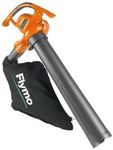Buying Guide for the Best Vacuum Lawn Sweepers
Choosing the right vacuum lawn sweeper can make yard maintenance much easier and more efficient. These devices are designed to pick up leaves, grass clippings, and other debris from your lawn, saving you time and effort compared to manual raking. When selecting a vacuum lawn sweeper, it's important to consider various specifications that will affect its performance and suitability for your specific needs. Understanding these key features will help you make an informed decision and ensure that you choose a model that fits your lawn care requirements.Sweeping WidthThe sweeping width of a vacuum lawn sweeper refers to the width of the area it can cover in a single pass. This is important because a wider sweeping width means you can cover more ground in less time, making the task of cleaning your lawn quicker and more efficient. Sweeping widths can vary from narrow models around 20 inches to wider models over 30 inches. If you have a large lawn, a wider sweeping width will be beneficial as it reduces the number of passes needed. However, for smaller lawns or areas with tight spaces, a narrower width might be more manageable and easier to maneuver.
Hopper CapacityThe hopper capacity of a vacuum lawn sweeper indicates how much debris it can hold before needing to be emptied. This is crucial for determining how often you'll need to stop and empty the hopper while cleaning your lawn. Hopper capacities can range from smaller sizes around 10 cubic feet to larger ones exceeding 20 cubic feet. If you have a large yard with a lot of debris, a larger hopper capacity will allow you to work longer without interruptions. Conversely, for smaller yards or less debris, a smaller hopper might suffice and be easier to handle.
Type of DebrisDifferent vacuum lawn sweepers are designed to handle various types of debris, such as leaves, grass clippings, pine needles, and even small twigs. It's important to consider the type of debris you most frequently encounter in your yard. Some sweepers are better suited for light, dry leaves, while others can handle heavier, wet debris. If your yard has a mix of debris types, look for a versatile model that can handle multiple kinds of debris effectively. Understanding your yard's specific needs will guide you in choosing a sweeper that performs well in your environment.
Adjustable Height SettingsAdjustable height settings on a vacuum lawn sweeper allow you to change the height of the brushes or the entire unit to better suit the terrain and type of debris. This feature is important because it enables you to optimize the sweeper's performance for different conditions, such as uneven ground or varying debris sizes. Height settings can range from a few inches to several, allowing for customization based on your lawn's needs. If your lawn has varied terrain or you deal with different debris types throughout the year, a model with adjustable height settings will provide greater flexibility and efficiency.
Ease of UseEase of use encompasses several factors, including the weight of the sweeper, the design of the handle, and how easy it is to empty the hopper. A vacuum lawn sweeper that is easy to maneuver and operate will make the task of cleaning your lawn less strenuous and more enjoyable. Consider models that are lightweight yet sturdy, with ergonomic handles that reduce strain during use. Additionally, look for features like easy-to-empty hoppers and simple assembly. If you prioritize convenience and comfort, focusing on ease of use will help you find a sweeper that meets your needs.







